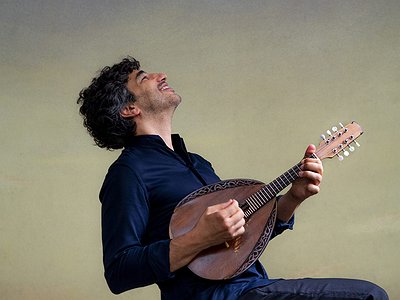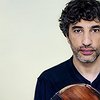Name: Avi Avital
Occupation: Mandolinist
Nationality: Israeli
Recent release: Avi Avital's Concertos is out via Deutsche Grammophon.
If you enjoyed this Avi Avital interview and would like to find out more about his music and current live dates, visit his official website. He is also on Facebook, and twitter.
When did you first start getting interested in musical interpretation?
My first experience with musical interpretation was when I was about four years old, although I was only able to express it more clearly when I was older. I remember a vinyl record we had at home, Vivaldi's Four Seasons. There was a particular part that I adored and requested to play repeatedly. The vinyl lacked its original cover and all I knew was that the composition was about the four seasons. I always referred to this particular segment as 'Winter.'
It was not until later, around the age of 17, when I attended a concert with the Four Seasons and held the program in my hands that, to my amazement, I found out that my favorite 'Winter' was actually the third movement of 'Summer' all this time.
This realization made me reflect on my four-year-old self's perception. I had, without any formal knowledge, experienced a magnificent storm through the music—rain, hail, thunder, lightning, the sensation of being small in the face of nature's might. However, as a child growing up in Israel, the last thing you would expect is a summer storm, so I had associated it with 'Winter' in my mind.
It taught me that musical interpretation should not solely be about how a summer storm sounds but more importantly, how it feels.
Which artists, approaches, albums or performances captured your imagination in the beginning when it comes to the art of interpretation?
When I was 19 years old, a music student at the time, I attended a performance by the Italian Baroque ensemble, Il Giardino Armonico, in Jerusalem. The moment they stepped onto the stage, it was abundantly clear that I was about to encounter something unlike anything I had experienced before. They pushed the boundaries of the music in every conceivable way, and the sheer energy emanating from the stage was nothing short of breathtaking.
This experience highlighted the immense influence interpreters hold in bringing composed music to life. It also underscored the essential role played by the audience, even if silent, in co-creating such an immersive and powerful artistic encounter.
Are there examples for interpretations that were entirely surprising to you personally and yet completely convincing?
Bach's Harpsichord Concerto in D minor, BWV 1052, is a piece that I've arranged for the mandolin and performed numerous times.
Over the years, I've developed my interpretation, honed through many hours with it on stage in concerts and dedicated study. I've analyzed the music, delved into its intricacies, and listened to other accomplished interpreters.
Recently, I revisited Glenn Gould's recording of the concerto, which, at the first seconds, seemed to me painfully slower than how I would typically perform it. The orchestral and piano sounds felt somewhat heavy and outdated when compared to the current performance practices.
However, to my surprise, I found myself unable to turn away from Gould's rendition. It captivated and enchanted me in the most remarkable way.
This experience reinforced a fundamental lesson: there's no 'right' or 'wrong' interpretation, and there are numerous paths to cast a spell on a listener. This is especially true when the composition itself, like Bach's work, is inherently perfect.
What do you personally enjoy about the act of interpretation? Are you finding that this sense of enjoyment is changing over time?
What I find most gratifying about interpretation is the fusion of craftsmanship and spirit. It's a deeply intuitive expression of one's entire being, encompassing inspirations, life experiences, musical journeys, knowledge, thoughts, and instincts. When substantial interpretation is invested in any endeavor, it imparts a special energy to that creation or action.
For instance, if a carpenter dedicates their life to crafting tables while constantly pondering every detail of the craft, from materials to proportions, envisioning the final product, and continually reflecting and refining their skills, you can be certain that after years of such devotion, that piece of furniture will radiate energy.
Some call that 'soul.' This principle extends to music, cooking, parenting - essentially every thing.
How much creativity is there in the act of interpretation? How much of your own personality enters the process?
The act of interpretation beautifully combines craftsmanship with intuition or some would even say spirituality, though it's a complex phenomenon to put into words.
I remember when I first performed Vivaldi's concerto RV93, in the second movement, there was a singular moment of extreme delicacy and tenderness, an uplifting sense of melancholy that moved me to tears while I played.
Be sure that at the 200th time that I’ve played it I no longer experienced the same emotional impact. It no longer surprises me as it once did.
Nevertheless, I hold onto the memory of that profound feeling, and I should know how to evoke it for the listener. In essence, my craft in that moment is the ability to squeeze a tear from the audience's eyes, not necessarily from my own.
Could you describe your approach to interpretation on the basis of a piece, live performance or album that's particularly dear to you, please?
I'd like to share my approach to interpretation using Bach's keyboard concerto BWV 1056, specifically its second movement. This sublime piece is essentially a beautiful delicate melody over a steady rhythm from the orchestra. It's divided into five “big” phrases, each with its unique emotional flavour, too complex to put in words, but in my free interpretation I’d include longing, melancholy, hope, strength, faith and doubt.
To emphasize the fragility of these emotions, I instructed the orchestra perform the entire movement in 'Pizzicato', except for the very end, which serves as a wake-up call from the dreamy journey. In contrast to the orchestra's steady eighth-note accompaniment, the melody floats freely on top, as if it were being improvised, detached from the predictable rhythm of the accompaniment.
In my interpretation, this presents an opportunity to play around with the alignment of the solo part with the accompaniment. At times, I deliberately place my notes slightly ahead or behind the beat, creating a sense of separation and enhancing the independent nature of the melody. This approach is carefully modulated, and during the brief cadenzas that conclude each phrase, I unite with the accompaniment to provide stability and release the accumulated tension.
The art of interpretation involves the skillful brewing of tension and the subsequent release, not just within individual phrases but across the entire piece. Notably, this movement concludes with a significant unresolved tension in the form of a dominant chord, which is resolved with the first note of the subsequent movement, inviting the listener to continue the journey.
What was your own learning curve/creative development like when it comes to interpretation - what were challenges and breakthroughs?
One memorable moment of realisation I had was when my son was a baby. I used to play the classic game of 'peek-a-boo' with him, where you cover your face and then uncover it to make the baby laugh. I was trying to improve my timing in this game and would challenge myself to see how many rounds of 'peek-a-boo' I could do before my son got bored.
Think of it like a musical performance where the 'score' is the set of instructions for the game, which, in this case, are simple:
1. Cover your face.
2. Uncover your face.
The key is to create tension by covering your face and then release that tension when you uncover it, which makes the baby laugh in relief. However, as you play it repeatedly, the baby starts to predict what will happen next, and the tension isn't as strong anymore, and so the laughter becomes less intense.
So what can you, as a performer, do? You can enhance the tension by holding the covered face a bit longer, but not too long to lose the baby's interest – that’s in our musical world called 'timing' - or you can also pop your head out in a surprising or unexpected way etc ... I used to measure my success by how many times I could perform 'peek-a-boo' before it became too predictable.
These timings would obviously change if you played the game with two babies or with two hundred babies. Musical performance is the same, just much more complex. One's sensitivity to timing is a fundamental aspect of live performance.
Avi Avital Interview Image by Harald Hoffmann
In many cases, the score will be the first and foremost resource for an interpretation. Can you explain about how “reading” a score works for you?
It's a little bit like in recipes - theoretically, if you follow the instructions meticulously, the author's intended result should emerge. However, if you were to give the same exact recipe, let's say for Pasta Pomodoro, to both me and a Michelin-starred chef, it wouldn't be difficult to distinguish between our creations.
Essentially, the starting point should be understanding the desired effect this recipe is meant to evoke: Comfort? Surprise? Alertness (perhaps by adding pepperoncino)? Tenderness? Then, the chef draws upon their knowledge and experience acquired from working with both pastas and tomatoes countless times and in different contexts, utilizing all the little insights and tricks they've gathered over the years.
I believe that comprehending a piece of music should begin with an understanding of its structure, mechanics, and what it can convey, followed by an incorporation of all that knowledge. You then draw upon your wealth of experience to perform it. As one of my teachers always said, you must know the piece, but you must not play your knowledge.
One of the key phrases often used with regards to interpretation are the “composer's intentions”. What is your own perspective on this topic and its relevance for your own interpretations?
In Vivaldi's Four Seasons, in the second movement of Autumn, the Viola part is instructed to imitate distant dog barks.
The philological performance approach might involve a research of the specific dog breeds that existed in Venice during Vivaldi's time. One might delve into early 18th-century paintings featuring dogs, analyze their proportions, and speculate on the sounds these dogs might have produced according to the size and shape of their bodies.
Then, armed with this historical knowledge, you could approach the Viola player and ask them to imitate those sounds, aiming for a rendition that closely aligns with what Vivaldi might have had in mind. But that’s obviously not the point.
In Vivaldi's second movement for Autumn, he paints a vivid picture of a shepherd taking an afternoon nap beneath the trees. You can hear the gentle rustling of leaves in the wind through the violins' part providing the calmness of the scenery, one can even feel the temperature. It's a type of slumber that's sweet and peaceful but not entirely deep; there's still a connection to the world, a hint of something beyond the calmness, still disturbing it all while remaining in harmony with it.
As an interpreter, what matters most to me is not how such 'sleep' should feel (and we’ve all experienced it in our lives). My task is to create that feeling for the listener, even if they don't have the descriptive details that I see on my score.
When you have the score in front of you, what's your take on taking things literally, correcting possible mistakes, taking into account historical aspects etc?
I do take liberties with the score when I believe it's in the best interest of the performance. I consider it my responsibility to bring out the best in a piece.
I remember my struggle with a composition for mandolin, guitar, and harp by Hans Werner Henze titled 'Carillon, Recitatif, Masque'. The breakthrough I experienced with this piece came when I chose to disregard the composer's metronome markings and played it at a much faster tempo. Suddenly, the piece came alive for me and became significantly more effective to me.
In particular, in the third movement ‘Masque’ the composer's metronome marking was 80 bpm, but I recorded it at around 104 bpm, and I can't imagine it being any slower than that!
Some works seem to attract more artists to add their interpretation to it than others; some seem to even encourage wildly different interpretations. From your experience, what is it about these works that gives them this magnetic pull?
I believe that when a piece is well-composed and its architectural structure is perfect, it can withstand various interpretations and still have a profound impact.
An excellent example of this is Bach. His compositions are so impeccably crafted that the tempo, dynamics, and even the choice of instrument become secondary. You can instantly recognize Bach's signature, and the music remains remarkably powerful. 
Avi Avital Interview Image by Harald Hoffmann
Artists can return to a work several times throughout the course of their career, with different results. Tell me about a work where this has been the case for you, please.
For me, Bach's Chaconne is a piece that has been a constant companion for over 25 years. Yet, I have the feeling that almost every time I perform it, I unearth another subtle detail, an inner, hidden phrase that I hadn't noticed before.
As I've become familiar with many of these nuances over the years, I've stopped practising it extensively before concerts. I want the composition to surprise me, to take me on a different journey each time I play it.
I know that it will be different every night, but I also trust that it will be the right journey, excluding of course the occasional wrong note that happens to everyone.






